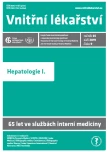Current knowledge of hepatitis E virus related disease
Authors:
Matúš Mihalčin; Petr Husa
Authors‘ workplace:
Klinika infekčních chorob LF MU a FN Brno, pracoviště Bohunice
Published in:
Vnitř Lék 2019; 65(9): 564-569
Category:
Overview
Hepatitis E virus (HEV) infection is one of the most common causes of acute hepatitis worldwide. The Czech Republic is also a region with a natural occurrence of HEV genotype 3. Diseases caused by different genotypes have distinct clinical and epidemiological characteristics. In industrialized countries, numerous local animal reservoirs have been described and infection is considered to be zoonotic disease in these areas. The most significant route of transmission is through ingestion of insufficiently cooked meat of reservoir animals. In addition, numerous extrahepatic manifestations, even without dominant liver disease, and the possibility of chronic hepatitis in immunocompromised patients have been described. The review summarizes the current knowledge of HEV related disease and current approaches to the treatment of acute and chronic hepatitis E.
Keywords:
hepatitis E – treatment of acute/chronic HEV – virus hepatitis E (HEV) – management HEV in The Czech Republic
Sources
- Rein DB, Stevens GA, Theaker J et al. The global burden of hepatitis E virus genotypes 1 and 2 in 2005. Hepatol Baltim Md 2012; 55(4): 988–997. Dostupné z DOI: <http://doi: 10.1002/hep.25505>.
- [European Association for the Study of the Liver]. EASL Clinical Practice Guidelines on hepatitis E virus infection. J Hepatol 2018; 68(6): 1256–1271. Dostupné z DOI: <http://doi: 10.1016/j.jhep.2018.03.005>.
- Arends J, Ghisetti V, Irving W et al. Hepatitis E: An emerging infection in high income countries. J Clin Virol 2014; 59(9): 81–88. Dostupné z DOI: <http://doi: 10.1016/j.jcv.2013.11.013>.
- Vybrané infekční nemoci v ČR v letech 2008–2017 – relativně, SZÚ. Dostupné z WWW: <http://www.szu.cz/publikace/data/vybrane-infekcni-nemoci-v-cr-v-letech-2008–2017-relativne>.
- Němeček V, Butovičová P, Malý M et al. The prevalence of antibodies against Hepatitis E Virus in the Czech Republic: serological survey. Epidemiol Mikrobiol Imunol 2017; 66(1): 3–7.
- Kubankova M, Kralik P, Lamka J et al. Prevalence of Hepatitis E Virus in Populations of Wild Animals in Comparison with Animals Bred in Game Enclosures. Food Environ Virol 2015; 7 : 159–163. Dostupné z DOI: <http://doi 10.1007/s12560–015–9189–1>.
- Pischke S, Hartl J, Pas SD et al. Hepatitis E virus: Infection beyond the liver? J Hepatol 2017; 66(5): 1082–1095. Dostupné z DOI: <http://doi: 10.1016/j.jhep.2016.11.016>.
- Kamar N, Marion O, Abravanel F et al. Extrahepatic manifestations of hepatitis E virus. Liver Int Off J Int Assoc Study Liver 2016; 36(4): 467–472. Dostupné z DOI: <http://doi: 10.1111/liv.13037>.
- van Eijk JJ, Madden RG, van der Eijk AA et al. Neuralgic amyotrophy and hepatitis E virus infection. Neurology 2014; 82(6): 498–503. Dostupné z DOI: <http://doi: 10.1212/WNL.0000000000000112>.
- Negro F, Forton D, Craxì A et al. Extrahepatic morbidity and mortality of chronic hepatitis C. Gastroenterology 2015; 149(6): 1345–1360. . Dostupné z DOI: <http://doi: 10.1053/j.gastro.2015.08.035>.
- Haffar S, Bazerbachi F, Lake JR. HEV-associated cryoglobulinaemia and extrahepatic manifestations of hepatitis E. Lancet Infect Dis 2015; 15(3): 268. Dostupné z DOI: <http://doi: 10.1016/S1473–3099(15)70034–4>.
- Pas SD, Streefkerk RH, Pronk M et al. Diagnostic performance of selected commercial HEV IgM and IgG ELISAs for immunocompromised and immunocompetent patients. J Clin Virol Off Publ Pan Am Soc Clin Virol 2013; 58(4): 629–634. Dostupné z DOI: <http://doi: 10.1016/j.jcv.2013.10.010>.
- Avellon A, Morago L, Garcia-Galera MDC et al. Comparative sensitivity of commercial tests for hepatitis E genotype 3 virus antibody detection. J Med Virol 2015; 87(11): 1934–1939. Dostupné z DOI: <http://doi: 10.1002/jmv.24251>.
- Panda SK, Varma SP. Hepatitis E: Molecular Virology and Pathogenesis. J Clin Exp Hepatol 2013; 3(2): 114–124. Dostupné z DOI: <http://doi: 10.1016/j.jceh.2013.05.001>.
- Peters van Ton AM, Gevers TJG, Drenth JPH. Antiviral therapy in chronic hepatitis E: a systematic review. J Viral Hepat 2015; 22(12): 965–973. Dostupné z DOI: <http:// doi: 10.1111/jvh.12403>.
- Kamar N, Izopet J, Tripon S et al. Ribavirin for chronic hepatitis E virus infection in transplant recipients. N Engl J Med 2014; 370(12): 1111–1120. Dostupné z DOI: <http://doi: 10.1056/NEJMoa1215246>.
- Ferenci P. Silymarin in the treatment of liver diseases: What is the clinical evidence? Clin Liver Dis 2016; 7(1): 8–10. Dostupné z DOI: <http://doi: 10.1002/cld.522>.
- Mihalčin M, Fašaneková L et al. Aktuální pohled na epidemiologii a přístupy k léčbě virových hepatitid A a E. Klin Farmakol Farm 2017; 31(1): 15–18.
- Johne R, Trojnar E, Filter M et al. Thermal Stability of Hepatitis E Virus as Estimated by a Cell Culture Method. Appl Environ Microbiol 2016; 82(14): 4225–4231. Dostupné z DOI: <http:// doi: 10.1128/AEM.00951–162>.
- Wu T, Zhu FC, Huang SJ et al. Safety of the hepatitis E vaccine for pregnant women: a preliminary analysis. Hepatol Baltim Md 2012; 55(6): 2038. Dostupné z DOI: <http://doi: 10.1002/hep.25522>.
Labels
Diabetology Endocrinology Internal medicineArticle was published in
Internal Medicine

2019 Issue 9
Most read in this issue
- Noninvasive diagnostics of liver diseases – imaging methods
- Current knowledge of hepatitis E virus related disease
- Non-Alcoholic Fatty Liver Disease
- Current view on hepatitis B diagnosis and therapy
